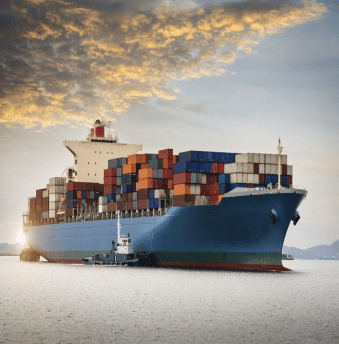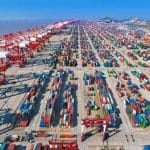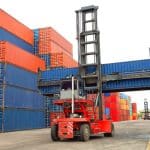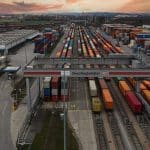NY-NJ RAIL LIFTS FALL AS LOW RATES ENTICE SHIPPERS TO TRUCK
The Port of New York and New Jersey saw a decline in rail volumes in the first half of 2022 as intermittent container embargoes at railroads and low trucking rates pushed shippers off the rails.
CARRIERS NEED TO SWEEP UP NY-NJ EMPTIES: FMC’S MAFFEI
Ocean carriers serving the Port of New York and New Jersey should do more to sweep up empty containers, according to FMC chairman Daniel Maffei, as the agency announces a broader look into the issue.
RECORD JULY PUTS PORT OF SAVANNAH ON PACE FOR 6 MILLION TEUS
The Port of Savannah continues to see “unprecedented” cargo volumes as it continues to pick up diverted capacity from the U.S. West Coast. The Georgia Ports Authority (GPA) announced Monday that July’s cargo volumes came in at 530,800 TEU, for an increase of 18% compared to last year. The number sets a new all-time monthly record, surpassing the previous record set in May 2022 by about 12,000 TEU. Since January, the Port of Savannah has moved 3.4 million TEU, up 231,400 TEU or 7% over its record performance in 2021 when Savannah moved 5.6 million TEU. July volumes put the Port of Savannah on pace to move more than 6 million TEUs per year. “The Port of Savannah has clearly become a preferred East Coast gateway for shippers globally, including cargo diverted from the U.S. West Coast,” said GPA Executive Director Griff Lynch. “Our expedited infrastructure projects, extended gate hours and the outstanding work of our employees and partners are key to our ability to move cargo at a record pace.”
PORT OF NEW YORK AND NEW JERSEY HOPES NEW CONTAINER IMBALANCE FEE CAN HELP CLEAR EMPTY CONTAINERS
The Port Authority of New York and New Jersey has announced a new “container imbalance fee” for ocean carriers to help clear long-dwelling empty containers during peak cargo season. The port, the largest on the East Coast and second in the nation behind the Port of Los Angeles, has been bogged down by record cargo volumes as cargo shifts from the West Coast, where lingering congestion and ongoing labour negotiations continue to pose wildcards for importers. Figures released by the Port Authority show an average of 19 ships waiting at anchor for the week ending July 29, with average wait times are little over 4 days. A glut of empty containers at the Port of New York and New Jersey have exacerbated congestion issues. Enter the container imbalance fee. “The container imbalance fee will be assessed on ocean carriers who do not evacuate empty containers that take up sorely needed space for arriving imports and impede overall port productivity and fluidity,” the Port Authority of New York and New Jersey said in an update. Under the program, which will be effective as of September 1, 2022, ocean carriers’ total outgoing container volume must equal or exceed 110% of their incoming container volume during the same period, or they will be assessed a fee of $100 per container for failing to hit the benchmark. Incoming and outgoing containers include both loaded and empty containers but exclude rail volume. The fee will be assessed on quarterly basis and proceeds will be used to offset the costs of providing additional storage capacity, and other expenses incurred by the glut of empty containers. The imbalance fee is different from the ports of Los Angeles and Long Beach’s “container dwell fee,” which continues to be postponed, in that it charges ocean carriers for empty export containers, rather loaded import containers, and it’s a flat $100 fee, not a compounding daily fee if long-dwelling containers remain in port. “The Port of New York and New Jersey is facing record import volumes, leading to empty containers accumulating in and around the port complex that are now affecting the regional supply chain that is already under stress from various sources across the country,” said Bethann Rooney, director of the Port Department at the Port Authority of New York and New Jersey. “We emphatically encourage ocean carriers to step up their efforts to evacuate empty containers quicker and at higher volumes to free up much needed capacity for arriving imports in order to keep commerce moving through the port and the region. “Year-to-date, the Port of New York and New Jersey has seen cargo volumes rise nearly 12% compared last year and an astounding rise of 34% compared to the same period during pre-pandemic 2019.

WEST TO EAST CARGO SHIFT CAUSING MOST SHIPS TO ARRIVE LATE AT EAST COAST PORTS
Less than one in five containerships are now arriving on time on the U.S. East Coast as the West to East coast cargo shift hits schedule reliability, East Coast ports have gained this year due to a continuing shift in container shipping capacity away the West Coast in the Far East to the United States trade. Unfortunately, this shift has caused congestion for East Coast ports as West Coast ports improves relative to their peak in late 2021 and early 2022. In fact, the situation on the East Coast has now deteriorated to the point where less than one in five container ships, or 18.7%, currently arrive on time. East Coast ports have seen cargo volumes increased nearly 12% this year and Sand notes that, in the past three months, capacity between the Far East and the US East Coast has risen by 18.9% year-on-year—translating to an average capacity of 210,000 TEU, the equivalent of carriers adding four 8,750 TEU ships, per week against 2021 levels.
While West Coast ports still enjoy the “lion’s share” of capacity from the Far East, year to date cargo volumes are down 8%, with May 2022 registering a significant 12.8% year-on-year decline, according to Xeneta. As a result, West Coast ports’ share of inbound cargo volumes from the Far East has fallen from over 66% in July 2021 to a little under 60% currently. Despite ongoing concerns portside, with the continued threat of industrial action from dockworkers, amongst other factors, those shipping to the West Coast will have enjoyed easing congestion of late. Fewer ships mean less pressure, and schedule reliability has now reached its highest level in over a year. Nevertheless, only 24.8% of ships are arriving on time – with an average delay of 9.9 days (against an average of nine days on the East Coast) – so there’s still a lot of work to be done. It’ll be very interesting to see how this develops, as well as, of course, how rates are impacted by the capacity adjustment and changing demand picture going forward.




